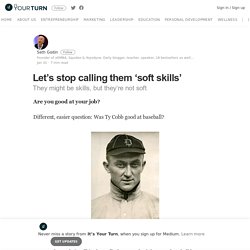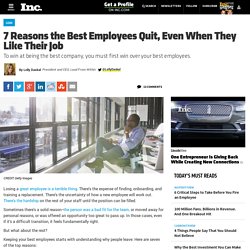

Economist. A New Business Strategy: Treating Employees Well - The Atlantic. NORWICH, VT—Call centers are not, typically, very happy places—especially around the holidays.

Workers have quotas to make, and often sit in bleak cubicles, headsets on, plowing through calls from stressed shoppers, as they count down the minutes until lunch. But the employees in this call center in Vermont are rosy-cheeked and—can it be? —smiling. They field calls about misplaced packages and gluten-free dough, while surrounded by orange and red Thanksgiving decorations and a wall lined with baking gear that they’re allowed to borrow. They still have quotas—10 calls per hour, per agent—but they know they won’t get fired if they spend 45 minutes talking to a woman with cancer about baking, as one agent recently did. “People just really care about each other and look out for each other,” said Julie Porter, a call center employee. Selfdeterminationtheory.org - An Approach to human motivation & personality.
Seth Godin's altMBA. This Important Boss-Employee Chat Can Get Awkward. Here's How to Avoid That. The biggest reason professionals switch jobs is to advance their career.

Hence, if people believe they can advance their career at your organization, you greatly diminish the odds of them leaving. It’s really that simple. But executing it is hard. There are a few aspects to getting this right. You need to have a culture where you look within for leaders, instead of externally. And, you need to do something many organizations skip over: your managers need to have honest career conversations with their employees.
But having these conversations can be tricky. Let’s stop calling them ‘soft skills’ – It’s Your Turn. Are you good at your job?

Different, easier question: Was Ty Cobb good at baseball? It’s generally understood that Ty Cobb was a jerk. His teammates didn’t like him very much. But he’s still in the Hall of Fame. That’s because baseball keeps score… of hits, of runs and of catches. What about your job? There are linchpins, people who don’t shirk responsibility when the chips are down. And yet… And yet we persist in hiring and training as if we’re a baseball team, as if easily defined skills are all that matter. What causes successful organizations to fail? Introduction to communities of practice. The concept of community of practice has found a number of practical applications in business, organizational design, government, education, professional associations, development projects, and civic life.

Organizations. The concept has been adopted most readily by people in business because of the recognition that knowledge is a critical asset that needs to be managed strategically. Initial efforts at managing knowledge had focused on information systems with disappointing results. Communities of practice provided a new approach, which focused on people and on the social structures that enable them to learn with and from each other. Today, there is hardly any organization of a reasonable size that does not have some form communities-of-practice initiative.
From this perspective, the knowledge of an organization lives in a constellation of communities of practice each taking care of a specific aspect of the competence that the organization needs. Communities of Practice The Organizational Frontier[1] Jim Hemerling: 5 ways to lead in an era of constant change. Shake up employee training in higher ed. All higher education institutions offer employee training and skill development in some form or another.

Workshops. Webinars. Mentoring. Coaching. It’s the same-old same-old—but does it have to be? Some schools have observed identical practices for decades. Gamifying PD Five years ago, Oakwood University in Huntsville, Alabama, began surveying students—along with staff and faculty—to identify skill gaps among the school’s workforce, says Prudence Pollard, vice president of research and faculty development. A cross-functional committee was charged with evaluating all responses to identify the top 10 concerns and recommend related training for the school’s frontline and leadership academies. The university encourages experimentation when it comes to training and development, Pollard says. For example, the school is exploring creative ways to include gamification in its PD activities to appeal to the next wave of workers. Beyond the comfort zone. 7 Reasons the Best Employees Quit, Even When They Like Their Job. Losing a great employee is a terrible thing.

There's the expense of finding, onboarding, and training a replacement. There's the uncertainty of how a new employee will work out. There's the hardship on the rest of your staff until the position can be filled. Sometimes there's a solid reason--the person was a bad fit for the team, or moved away for personal reasons, or was offered an opportunity too great to pass up. In those cases, even if it's a difficult transition, it feels fundamentally right.
But what about the rest? Keeping your best employees starts with understanding why people leave. 1. People don't want to think they're locked into a groove and will come to the same place and do the same thing every day for the next 20 or 40 years.